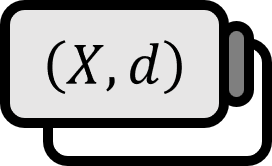Convergence of Sequences in Metric Spaces
Definitions1
If there exists a point $p \in X$ such that the sequence $\left\{ p_{n} \right\}$ of points in a metric space $(X,d)$ satisfies the following condition, the sequence $\left\{ p_{n} \right\}$ is said to converge to $p$, and it is denoted by $p_{n} \rightarrow p$ or $\lim \limits_{n\to \infty}p_{n}=p$.
$$ \forall \varepsilon >0,\ \exists N\in \mathbb{N}\ \mathrm{s.t}\ n\ge N \implies d(p_{n},p)<\varepsilon $$
If $\left\{ p_{n} \right\}$ does not converge, it diverges. Furthermore, the set of all $p_{n}$s is called the range of $\left\{ p_{n} \right\}$. If the range of $\left\{ p_{n} \right\}$ is bounded, the sequence $\left\{ p_{n} \right\}$ is said to be bounded.
Theorems
Let $\left\{ p_{n} \right\}$ be a sequence in a metric space $(X,d)$.
(a) A necessary and sufficient condition for $p_{n}\to p$ is that every neighborhood of $p$ contains all terms of $\left\{ p_{n} \right\}$ except for a finite number.
(b) If $p_{n} \to p$ and $p_{n} \to p^{\prime}$, then $p=p^{\prime}$.
(c) If $\left\{ p_{n} \right\}$ converges, it is bounded.
(d) Given $E\subset X$. If $p$ is a limit point of $E$, there exists a sequence $\left\{ p_{n} \right\}$ from $E$ that satisfies $p=\lim \limits_{n \to \infty}p_{n}$. Furthermore, if $\left\{ p_{n} \right\}$ is a set of distinct points, the converse also holds.
Proofs
(a)
$(\implies)$
Suppose $p_{n} \to p$. Given any positive number $\varepsilon >0$, let $V$ be a neighborhood of $p$ with radius $\varepsilon$. According to the definition of a neighborhood, the following holds:
$$ d(p,q)<\varepsilon\quad \implies q\in V $$
However, by assumption, there exists a $N$ that satisfies the following condition for the given $\varepsilon$:
$$ \forall n \ge N,\ d(p_{n},p) <\varepsilon $$
Therefore, all points $p_{n}$, except for a finite number, are included in $V$.
$(\impliedby)$
Assume every neighborhood of $p$ contains all but a finite number of points $\left\{ p_{n} \right\}$. Given any positive number $\varepsilon>0$, let $V$ be a neighborhood of $p$ with radius $\varepsilon$. Then, by assumption, a $N$ exists that satisfies the following condition:
$$ n \ge N \implies p_{n}\in V $$
Since $V$ is a neighborhood of $p$, the following holds:
$$ \forall n \ge N,\quad d(p_{n},p)<\varepsilon $$
Therefore, $p_{n}\to p$.
■
(b)
Given any positive number $\varepsilon >0$. By assumption, there exist two positive numbers $N$, $N^{\prime}$ that satisfy the following condition:
$$ \begin{align*} n\ge N & \implies d(p_{n},p) <\frac{\varepsilon}{2} \\ n\ge N^{\prime} & \implies d(p_{n},p) <\frac{\varepsilon}{2} \end{align*} $$
Then, for $n \ge \max(N,N^{\prime})$, the following equation holds:
$$ d(p,p^{\prime}) \le d(p,p_{n}) + d(p_{n},p^{\prime})<\varepsilon $$
Since $\varepsilon$ is any positive number,
$$ d(p,p^{\prime})=0 $$
and by the definition of distance, $p=p^{\prime}$.
■
(c)
Assume that $\left\{ p_{n} \right\}$ converges to $p$. By assumption, there exists a positive number $N$ that satisfies the following equation:
$$ n \ge N \implies d(p_{n},p)<1 $$
Now, let
$$ r=\max \left\{ 1,\ d(p_{1},p),\ \cdots,\ d(p_{N},p) \right\} $$
Then, for all $n$,
$$ d(p_{n},p)\le r $$
so $\left\{ p_{n} \right\}$ is bounded.
■
(d)
$(\implies)$
Assume $E\subset X$ and that $p$ is a limit point of $E$. By definition of a limit point, for each $n$,
$$ d(p_{n},p) < \frac{1}{n} $$
exists a $p_{n}\in E$. Now, given any positive number $\varepsilon >0$ and $N\varepsilon>1$ satisfying $N$, the following holds for $ n >N$:
$$ d(p_{n},p)< \frac{1}{n}<\frac{N}{n}\varepsilon<\varepsilon $$
Therefore, $\left\{ p_{n} \right\}$ converges to $p$.
$(\impliedby)$
Assume there exists a sequence $\left\{ p_{n} \right\}$ of distinct points from $E$ that satisfies $p=\lim \limits_{n\to\infty}p_{n}$. Then, for all positive numbers $\varepsilon >0$,
$$ n \ge N \implies d(p_{n},p)< \varepsilon $$
exists a $N$. Let $V_{\varepsilon}$ be a neighborhood of $p$ with radius $\varepsilon$. Thus, $V_{\varepsilon}$ includes $p_{n} \in E (n\ge N)$ which is not $p$, proving $p$ is a limit point of $E$.
■
Walter Rudin, Principles of Mathematical Analysis (3rd Edition, 1976), p47-48, 55-58 ↩︎
